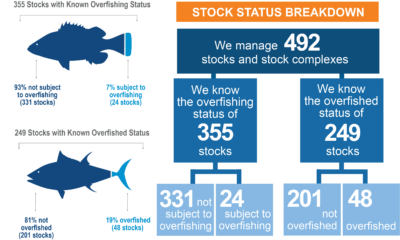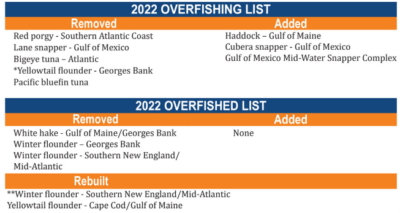NOAA Releases Status of Stocks Annual Report
Keith Lusher 05.15.23
The National Oceanic and Atmospheric Administration’s (NOAA) has released its 2022 Report to Congress on the Status of U.S. Fisheries. The top headline of the report good news for fishermen who who ultimately want to see regulations loosened in the future. The report showed that in 2022, the number of stocks on the overfished list decreased slightly from 51% to 48%. Among those fish taken off of the overfished list were White Hake in the Gulf of Maine and Georges Bank, and Winter Flounder in Georges Bank and Southern New England, and Mid Atlantic. The number of overfishing stocks also slightly decreased, and two stocks were rebuilt. “We continue to implement management measures that will end overfishing, rebuild overfished stocks, and sustain our fisheries for future generations,” NOAA said.

Another category called “Overfishing” saw an overall decrease from 26% to 24% with Red Porgy, Lane Snapper, Big Eye Tuna, Yellowtail Flounder, and Pacific Bluefin Tuna being removed from the list. Haddock and Cubera Snapper where added to the list. The reason for these two fish being added was due to an assessment that found that the Gulf of Maine Haddock stock declined unexpectedly, resulting in catch levels that were too high.
Additionally, catch overages resulted in overfishing listings for Gulf of Mexico Cubera Snapper and the Gulf of Mexico Mid-Water Snapper Complex. NOAA said that Fisheries managers should develop appropriate stock-specific measures that will end overfishing immediately on these stocks.

If you’re confused by the terms “overfishing” and “overfished” just think of it like this. Overfishing means that a certain species of fish is in the process of being depleted to the point that it will be classified at Overfished. When a stock becomes overfished, a Council (or for Atlantic highly migratory species, NMFS) must develop a plan to rebuild the stock to a sustainable target level. Typically, the plan allows fishing to continue at a reduced level so the stock can rebuild to its target level and produce its MSY.
“Despite the complex challenges associated with fishery management, working with our partners and stakeholders we continually adapt our management response with innovative solutions using the most updated scientific information available. We are committed to reducing the number of stocks that are overfished and subject to overfishing, and to rebuilding stocks that support sustainable fisheries in our changing climate,” said NOAA.

